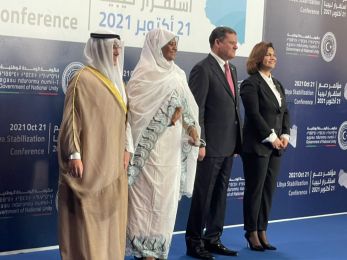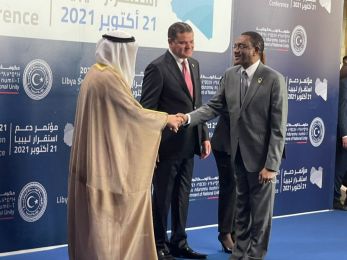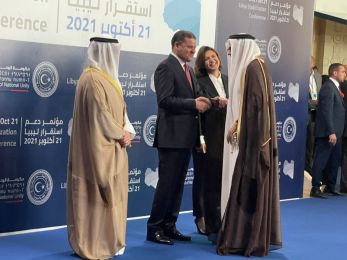PANAPRESS
Panafrican News Agency
Ghana trims monetary policy rate to 13 per cent
Accra, Ghana (PANA) – Ghana's economic managers on Friday trimmed the monetary policy rate by 0.50 per cent to 13 per cent as inflation continues to slide and economic environment improves.
“Given the balance of risks to prices and output growth and recognition of the improved economic environment, the Monetary Policy Committee has decided to reduce the Monetary Policy Rate by 50 basis points to 13 per cent,” Dr Kwesi Amissah-Arthur, the Governor of the Bank of Ghana, told a press conference on Friday after a week-long quarterly meeting of the committee.
He said the inflation target would be driven by a sustained and stable macro-economic environment anchored in a sound monetary and fiscal policy framework.
Ghana’s annual rate of inflation slipped to 9.02 per cent in April from 9.13 per cent in March with low food prices seen as a major factor, the Ghana Statistical Service (GSS) said on Wednesday.
Government Statistician, Dr Grace Bediako, said the month saw a downward trend in the food and non-alcoholic beverages group.
Amissah-Arthur said: “While uncertainties still exist in the outlook, especially in the movement of crude oil prices it is imperative that expenditure management will continue to be strengthened to sustain the desired inflation profile."
Mr Amissah-Arthur, who is also the Chairman of the MPC, said the Bank of Ghana's composite index of economic activity registered a real growth of 23.7 per cent in year-on-year terms in the first quarter of 2011 compared with a growth of 9.1 per cent recorded in the last quarter of 2010.
All indicators contributed positively to the growth of the index, but the contribution of credit to the private sector by commercial banks remains weak, he added.
"Overall business confidence increased marginally, driven by the positive assessment by businesses of economic conditions, expectations of future price trends and declining interest rates."
On the other hand, consumer confidence declined, attributed mainly to concerns about global commodity prices and the possibility of further fuel price increases, he added
Gross International Reserves declined from 4.7 billion dollars at the end of 2010 to 4.5 billion dollars by March 2011.
However at the end of April 2011, the Gross International Reserves improved to 4.9 billion dollars, representing 3.8 months import cover mainly as a result of portfolio inflows associated with the issue of the 3-year bond.
The reserve figure excludes 112 million dollars being proceeds from the first oil entitlement, currently in an interest-bearing escrow account belonging to the Bank of Ghana. Ghana began pumping oil in commercial quantities earlier this year.
Mr Amissah-Arthur said provisional data during the first quarter of 2011 indicated a strong revenue performance, although the increase in revenue was matched by an equally strong increase in expenditure.
Total revenue and grants for the first quarter of 2011 amounted to GH¢2.2 billion representing 4.1 per cent of GDP. (GH¢1.50=US$1.00)
He said total expenditure (excluding foreign financed capital expenditure) for the first quarter
of 2011 amounted to GH¢2.7 billion (5.2 per cent of GDP).
Wages and salaries and related expenditures amounted to GH¢869.6 million (1.6 per cent of GDP), absorbing close to 42.1 per cent of domestic revenues.
On external sector developments the Governor said total merchandise exports during the period were estimated at US$3 billion, representing a growth of 61.7 per cent year-on-year and was boosted by petroleum exports, higher commodity prices and larger export volumes.
Export earnings in the first quarter of 2011 were US$1.9 billion. Export receipts of cocoa beans and products, one of Ghana's chief exports, amounted to US$859.4 million compared with US$682.5 million for 2010.
The export value of gold was US$1.2 billion, compared to US$787 million in 2010, while exports of crude oil were estimated at US$484.2 million for the first quarter of 2011.
On the other hand, total merchandise imports amounted to US$3.3 billion during the first three months of the year, compared with US$2.5 billion for the same period in 2010, showing an increase of 32 per cent.
-0- PANA MA 13May2011
“Given the balance of risks to prices and output growth and recognition of the improved economic environment, the Monetary Policy Committee has decided to reduce the Monetary Policy Rate by 50 basis points to 13 per cent,” Dr Kwesi Amissah-Arthur, the Governor of the Bank of Ghana, told a press conference on Friday after a week-long quarterly meeting of the committee.
He said the inflation target would be driven by a sustained and stable macro-economic environment anchored in a sound monetary and fiscal policy framework.
Ghana’s annual rate of inflation slipped to 9.02 per cent in April from 9.13 per cent in March with low food prices seen as a major factor, the Ghana Statistical Service (GSS) said on Wednesday.
Government Statistician, Dr Grace Bediako, said the month saw a downward trend in the food and non-alcoholic beverages group.
Amissah-Arthur said: “While uncertainties still exist in the outlook, especially in the movement of crude oil prices it is imperative that expenditure management will continue to be strengthened to sustain the desired inflation profile."
Mr Amissah-Arthur, who is also the Chairman of the MPC, said the Bank of Ghana's composite index of economic activity registered a real growth of 23.7 per cent in year-on-year terms in the first quarter of 2011 compared with a growth of 9.1 per cent recorded in the last quarter of 2010.
All indicators contributed positively to the growth of the index, but the contribution of credit to the private sector by commercial banks remains weak, he added.
"Overall business confidence increased marginally, driven by the positive assessment by businesses of economic conditions, expectations of future price trends and declining interest rates."
On the other hand, consumer confidence declined, attributed mainly to concerns about global commodity prices and the possibility of further fuel price increases, he added
Gross International Reserves declined from 4.7 billion dollars at the end of 2010 to 4.5 billion dollars by March 2011.
However at the end of April 2011, the Gross International Reserves improved to 4.9 billion dollars, representing 3.8 months import cover mainly as a result of portfolio inflows associated with the issue of the 3-year bond.
The reserve figure excludes 112 million dollars being proceeds from the first oil entitlement, currently in an interest-bearing escrow account belonging to the Bank of Ghana. Ghana began pumping oil in commercial quantities earlier this year.
Mr Amissah-Arthur said provisional data during the first quarter of 2011 indicated a strong revenue performance, although the increase in revenue was matched by an equally strong increase in expenditure.
Total revenue and grants for the first quarter of 2011 amounted to GH¢2.2 billion representing 4.1 per cent of GDP. (GH¢1.50=US$1.00)
He said total expenditure (excluding foreign financed capital expenditure) for the first quarter
of 2011 amounted to GH¢2.7 billion (5.2 per cent of GDP).
Wages and salaries and related expenditures amounted to GH¢869.6 million (1.6 per cent of GDP), absorbing close to 42.1 per cent of domestic revenues.
On external sector developments the Governor said total merchandise exports during the period were estimated at US$3 billion, representing a growth of 61.7 per cent year-on-year and was boosted by petroleum exports, higher commodity prices and larger export volumes.
Export earnings in the first quarter of 2011 were US$1.9 billion. Export receipts of cocoa beans and products, one of Ghana's chief exports, amounted to US$859.4 million compared with US$682.5 million for 2010.
The export value of gold was US$1.2 billion, compared to US$787 million in 2010, while exports of crude oil were estimated at US$484.2 million for the first quarter of 2011.
On the other hand, total merchandise imports amounted to US$3.3 billion during the first three months of the year, compared with US$2.5 billion for the same period in 2010, showing an increase of 32 per cent.
-0- PANA MA 13May2011






